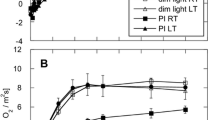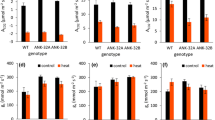Abstract
Carotenoid composition is important for plant protection against unfavorable environment. In the present study the effect of several days treatment with high light illumination at low temperature (500 µmol photons m−2 s−1 and (12/10 °C) on Arabidopsis thaliana plants—wt and mutant lut2, was investigated. In addition, a comparative study of the ability of wt and lut2 plants to recover after one week return to control conditions was performed. The response of wt and lut2 to both stress factors was evaluated by changes in net photosynthesis, photochemistry and energy distribution and interaction between both photosystems. The alterations in oxygen evolving capacity were evaluated by registration of flash-induced oxygen yields and kinetics of initial oxygen burst. For the first time the effect of exposure at low temperature/high light on the fluidity of thylakoid membranes isolated from wt and lut2 mutant was followed. The analysis of low temperature (77 K) fluorescence emission and excitation spectra revealed that during exposition to both stress factors the antenna size of photosystem I and photosystem II were affected. Lut2 mutant showed higher sensitivity to the inhibitory action of high light at low temperature, with the grana-situated photosystem II centers being more affected. However, lut2 mutant exhibited a higher ability to restore the photosynthetic activity after recovery period under control conditions. Data presented showed that at low temperature, complete replacement of lutein in lut2 mutant by xanthophyll cycle-associated carotenoids did not result in higher protection against high light, but facilitated better recovery during the recovery period.








Similar content being viewed by others
References
Adams WW III, Zarter CR, Mueh KE, Amiard V, Demmig-Adams B (2008) Energy dissipation and photoinhibition: a continuum of photoprotection. In: Demmig-Adams B, Adams W, Mattoo A (eds) Photoprotection, photoinhibition, gene regulation, and environment. Springer, Dordrecht, pp 49–64
Allen DJ, Ort DR (2001) Impact of chilling temperatures on photosynthesis in warn-climate plants. Trends Plant Sci 6:36–42
Aro E-M, Tyystjärvi E, Kettunen R (1994) The rate constant of photoinhibition in vitro is independent of the antenna size of Photosystem II but depends on temperature. Biochim Biophys Acta 1186:177–185
Aro E-M, Virgin I, Andersson B (1993) Photoinhibition of photosystem II. Inactivation, protein damage and turnover. Biochim Biophys Acta 1143:113–134
Bricker TM, Frankel LK (2011) Auxiliary functions of the PsbO, PsbP and PsbQ proteins of higher plant Photosystem II: a critical analysis. J Photochem Photobiol B 104:165–178
Bruce D, Samson G, Carpenter C (1997) The origins of non-photochemical quenching of chlorophyll in photosynthesis. Direct quenching by P680(+) in photosystem II enriched membranes at low pH. Biochemistry 36:749–755
Bykowski M, Mazur R, Wojtowicz J, Suski S, Garstka M, Mostowska A, Kowalewska L (2020) Too rigid to fold: Carotenoid-dependent decrease in thylakoid fluidity hampers the formation of chloroplast grana. Plant Physiol. https://doi.org/10.1093/plphys/kiaa009
Croce R, van Amerongen H (2020) Light harvesting in oxygenic photosynthesis: structural biology meets spectroscopy. Science 369:eaay2058. https://doi.org/10.1126/science.aay2058
Dall’Osto L, Lico C, Alric J, Giuliano G, Havaux M, Bassi R (2006) Lutein is needed for efficient chlorophyll triplet quenching in the major LHCII antenna complex of higher plants and effective photoprotection in vivo under strong light. BMC Plant Biol 6:32
Dall’Osto L, Fiore A, Cazzaniga S, Giuliano G, Bassi R (2007) Different roles of α- and β-branch xanthophylls in photosystem assembly and photoprotection. J Biol Chem 282:35056–35068
Danielsson R, Albertsson PA, Mamedov F, Styring S (2004) Quantification of photosystem I and II in different parts of the thylakoid membrane from spinach. Biochim Biophys Acta 1608:53–61
Dekker JP, Boekema EJ (2005) Supramolecular organization of thylakoid membrane proteins in green plants. Biochim Biophys Acta 1706:12–39
Dobrev K, Stanoeva D, Velitchkova M, Popova AV (2016) The lack of lutein accelerates the extent of light-induced bleaching of photosynthetic pigments in thylakoid membranes of Arabidopsis thaliana. Photochem Photobiol 92:436–445
Domonkos I, Kis M, Gombos Z, Ughy B (2013) Carotenoids, versatile components of oxygenic photosynthesis. Prog Lipid Res 52:539–556
Ensminger I, Busch F, Huner NPA (2006) Photostasis and cold acclimation: sensing low temperature through photosynthesis. Physiol Plant 126:28–44
Faik A, Stanoeva D, Velitchkova M (2018) High light enhanced the inhibitory effect of suboptimal temperatures on oxygen evolving reactions in Arabidopsis thaliana. C R Bulg Acad Sci 71:211–219
Frank HA, Cogdell RJ (1996) Carotenoids in photosynthesis. Photochem Photobiol 63:257–264
Gray CR, Savitch LV, Ivanov AG, Huner NPA (1996) Photosystem II excitation pressure and development of resistance to photoinhibition. Plant Physiol 110:61–71
Gruszecki WI, Strzalka K (2005) Carotenoids as modulators of lipid membrane physical properties. Biochim Biophys Acta 1740:108–115
Gu Y, He L, Zhao C, Wang F, Yan B, Gao Y, Li Z, Yang K, Xu J (2017) Biochemical and transcriptional regulation of membrane lipid metabolism in maize leaves under low temperature. Front Plant Sci 8:2053
Havaux M, Niyogi KK (1999) The violaxanthin cycle protects plants from photooxidative damage by more than one mechanism. Proc Natl Acad Sci USA 96:8762–8767
Horton P, Ruban A (1992) Regulation of photosystem II. Photosynth Res 34:375–385
Huang H-Y, Zhang Q, Zhao LP, Feng J-N, Peng C-L (2010) Does lutein plays a key role in the photoprotection of photosynthetic apparatus in Arabidopsis under severe oxidative stress? Pak J Bot 42:2765–2774
Ivanova PI, Dobrikova AG, Taneva SG, Apostolova EL (2008) Sensitivity of the photosynthetic apparatus to UV-A radiation: role of light-harvesting complex II–photosystem II supercomplex organization. Radiat Environ Biophys 47:169–177
Jahns P, Holzwarth AR (2012) The role of xanthophylls cycle and of lutein in photoprotection of photosystem II. Biochim Biophys Acta 1817:182–193
Kalituho L, Rech J, Jahns P (2007) The roles of specific xanthophylls in light utilization. Planta 225:423–439
Kok B, Forbush B, McGloin M (1970) Co-operation of charges in photosynthetic O2 evolution. I. A linear four step mechanism. Photochem Photobiol 11:457–475
Koochak H, Puthiyaveetil S, Mullendore DL, Li M, Helmut Kirchhof H (2019) The structural and functional domains of plant thylakoid membranes. Plant J 97:412–429
Kovacs T, Szalontai B, Kłodawska K, Vladkova R, Malec P, Gombos Z, Laczko-Dobos H (2019) Photosystem I oligomerization affects lipid composition in Synechocystis sp. PCC 6803. Biochim Biophys Acta Mol Cell Biol Lipids 1864(10):1384–1395
Laemmli U (1970) Cleavage of structural proteins during the assembly of the head of bacteriophage T4. Nature 227:680–685
Lazarova D, Stanoeva D, Popova A, Vasilev D, Velitchkova M (2014) UV-B-induced alteration of oxygen evolving reactions in pea thylakoid membranes as affected by scavengers of reactive oxygen species. Biol Plant 58:319–327
Lichtenthaler HK (1987) Chlorophylls and carotenoids: pigments of photosynthetic membranes. Methods Enzymol 148:350–382
Lindlöf A (2010) Interplay between low-temperature pathways and light reduction. Plant Signal Behav 5:820–825
Lokstein H, Tian L, Polle J, DellaPenna D (2002) Xanthophyll biosynthetic mutants of Arabidopsis thaliana: altered nonphotochemical quenching of chlorophyll fluorescence is due to changes in photosystem II antenna size and stability. Biochim Biophys Acta 1553:309–319
Los DA, Mironov KS, Allakhverdiev SI (2013) Regulatory role of membrane fluidity in gene expression and physiological functions. Photosynth Res 116:489–509
Lydakis-Simantiris N, Hutchison RS, Betts SD, Barry BA, Yocum CF (1999) Manganese stabilizing protein of photosystem II is a thermostable, natively unfolded polypeptide. Biochemistry 38:404–414
Mazur R, Gieczewska K, Kowalewska Ł, Kuta A, Proboszcz M, Gruszecki WI, Mostowska A, Garstka M (2020) Specific composition of lipid phases allows retaining an optimal thylakoid membrane fluidity in plant response to low-temperature treatment. Front Plant Sci 11:723
Melis A, Guenther GE, Morrissey PJ, Ghirardi ML (1988) Photosystem II heterogeneity in chloroplasts. In: Lichtenthaler HK (ed) Applications of chlorophyll fluorescence in photosynthesis research, stress physiology, hydrobiology and remote sensing. Springer, Dordrecht, pp 33–43
Moskalenko AA, Karapetyan NV (1996) Structural role of carotenoids in photosynthetic membranes. Z Nat 51c:763–771
Niyogi KK, Shih C, Chow WS, Pogson BJ, DellaPenna D, Bjoerkman O (2001) Photoprotection in a zeaxanthin- and lutein-deficient double mutant of Arabidopsis. Photosynth Res 67:139–145
Pawłowicz I, Kosmala A, Rapacz M (2012) Expression pattern of the psbO gene and its involvement in acclimation of the photosynthetic apparatus during abiotic stresses in Festuca arundinacea and F. Pratensis. Acta Physiol Plant 34:1915–1924
Peng C-L, Gilmore AM (2003) Contrasting changes of photosystem 2 efficiency in Arabidopsis xanthophyll mutants at room or low temperature under high irradiance stress. Photosynthetica 41:233–239
Plumley FG, Schmidt DW (1987) Reconstitution of chlorophyll a/b light-harvesting complexes: xanthophyll-dependent assembly and energy transfer. Proc Natl Acad Sci USA 84:146–150
Pogson B, McDonald KA, Truong M, Britton G, DellaPenna D (1996) Arabidopsis carotenoid mutants demonstrate that lutein is not essential for photosynthesis in higher plants. Plant Cell 8:1627–1639
Popova AV, Velitchkova M, Zanev Y (2007) Effect of membrane fluidity on photosynthetic oxygen production reactions. Z Nat 62c:253–260
Popova AV, Dobrev K, Velitchkova M, Ivanov AG (2019) Differential temperature effects on dissipation of excess light energy and energy partitioning in lut2 mutant of Arabodopsis thaliana under photoinhibitory conditions. Photosynth Res 139:367–385
Pospíšil P, Yamamoto Y (2017) Damage to photosystem II by lipid peroxidation products. Biochim Biophys Acta 1861:457–466
Raju SKK, Barnes AC, Schnable JC, Roston RL (2018) Low-temperature tolerance in land plants: are transcript and membrane responses conserved? Plant Sci 276:73–86
Ruban A (2016) Nonphotochemical chlorophyll fluorescence quenching: mechanisms and effectiveness in protecting plants from photodamage. Plant Physiol 170:1903–1916
Skupien J, Wojtowicz J, Kowalewska L, Mazur R, Garstka M, Gieczewska K, Mostowska A (2017) Dark-chilling induces substantial structural changes and modifies galactolipid and carotenoid composition during chloroplast biogenesis in cucumber (Cucumis sativus L) cotyledons. Plant Physiol Biochem 111:107–118
Szilagyi A, Selstam E, Akerlund HE (2008) Laurdan fluorescence spectroscopy in the thylakoid bilayer: the effect of violaxanthin to zeaxanthin conversion on the galactolipid dominated lipid environment. Biochim Biophys Acta 1778:348–355
Velitchkova M, Popova AV (2005) High light induced changes of 77 K fluorescence emission of pea thylakoid membranes with altered membrane fluidity. Bioelectrochemistry 67:81–90
Velitchkova M, Lazarova D, Popova A (2009) Response of isolated thylakoid membranes with altered fluidity to short term heat stress. Physiol Mol Biol Plants 15:43–52
Velitchkova M, Doltchinkova V, Lazarova D, Mihailova G, Doncheva S, Georgieva K (2013) Effect of high temperature on dehydration-induced alterations in photosynthetic characteristics of the resurrection plant Haberlea rhodopensis. Photosynthetica 51:630–640
Velitchkova M, Popova AV, Faik A, Gerganova M, Ivanov AG (2020) Low temperature and high light dependent dynamic photoprotective strategies in Arabidopsis thaliana. Physiol Plant 170:93–108
Vigh L, Horvath I, van Hasselt PR, Kuiper PJC (1985) Effect of frost hardening on lipid and fatty acid composition of chloroplast thylakoid membranes in two wheat varieties of contrasting hardiness. Plant Physiol 79:756–759
Ware MA, Dall’Osto L, Ruban AV (2016) An in vivo quantitative comparison of photoprotection in Arabidopsis xanthophyll mutants. Front Plant Sci 7:841
Yruela I, Tomás R, Sanjuán ML, Torrado E, Aured M, Picorel R (1998) The configuration of β-carotene in the photosystem II reaction center. Photochem Photobiol 68:729–737
Yu S-G, Björn LO (1996) Differences in UV-B sensitivity between PSII from grana lamellae and stroma lamellae. J Photochem Photobiol B 34:35–38
Zeinalov Y (2002) An equipment for investigations of photosynthetic oxygen production reactions. Bulg J Plant Physiol 28:57–67
Zheng G, Li L, Li W (2016) Glycerolipidome responses to freezing- and chilling-induced injuries: examples in Arabidopsis and rice. BMC Plant Biol 16:70
Acknowledgements
This study was supported by Bulgarian Science Fund under Research Project КП-06-Н26/11.
Author information
Authors and Affiliations
Corresponding author
Additional information
Publisher’s note
Springer Nature remains neutral with regard to jurisdictional claims in published maps and institutional affiliations.
Supplementary Information
Below is the link to the electronic supplementary material.
Rights and permissions
About this article
Cite this article
Velitchkova, M., Borisova, P., Vasilev, D. et al. Different impact of high light on the response and recovery of wild type and lut2 mutant of Arabidopsis thaliana at low temperature. Theor. Exp. Plant Physiol. 33, 95–111 (2021). https://doi.org/10.1007/s40626-021-00197-y
Received:
Accepted:
Published:
Issue Date:
DOI: https://doi.org/10.1007/s40626-021-00197-y




